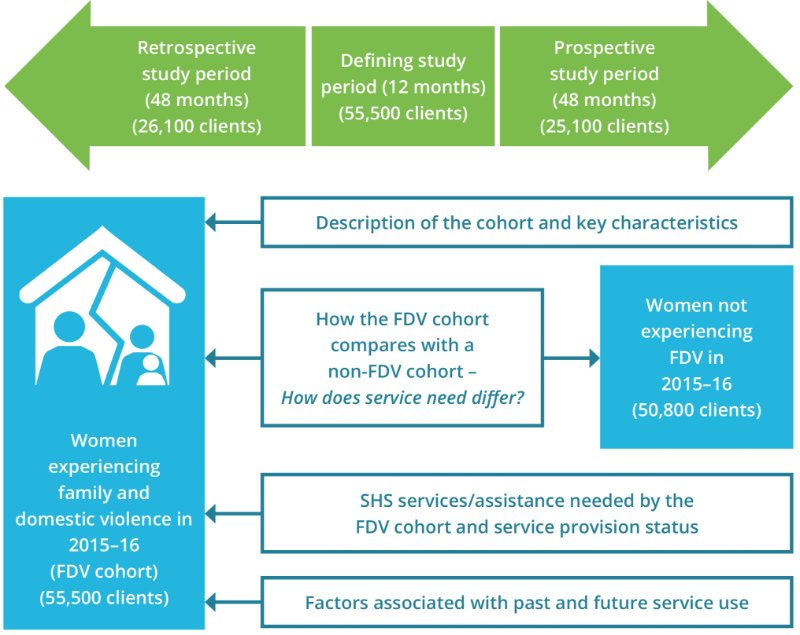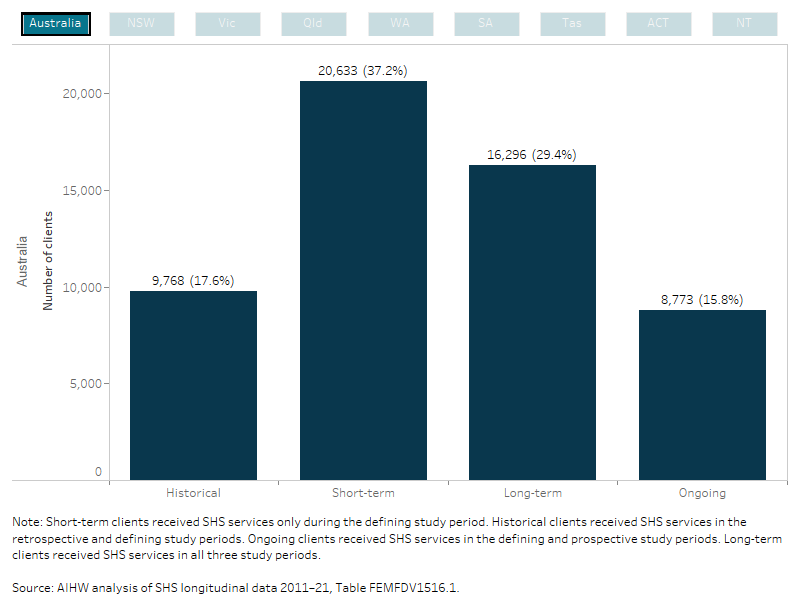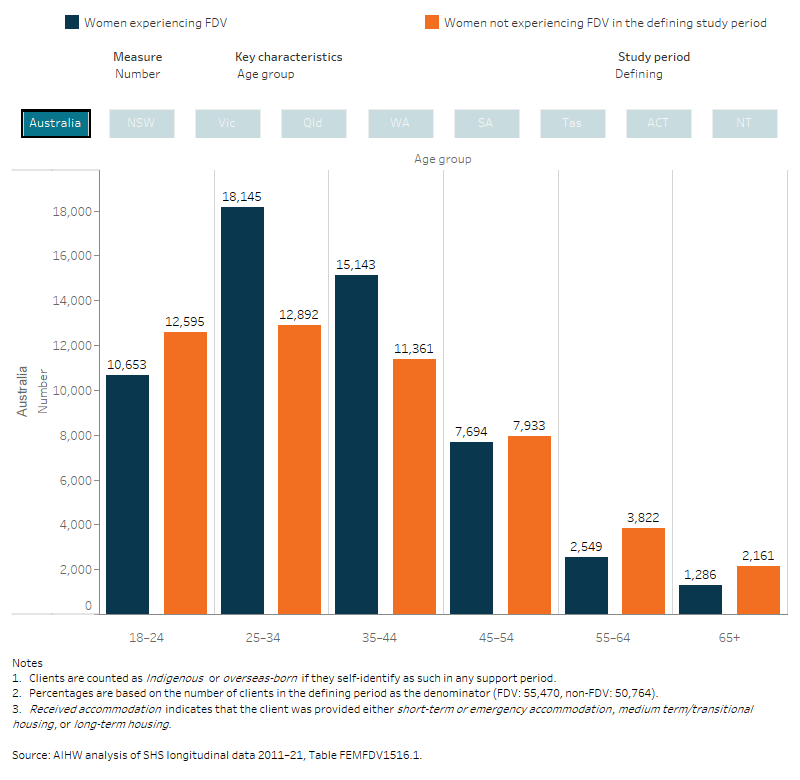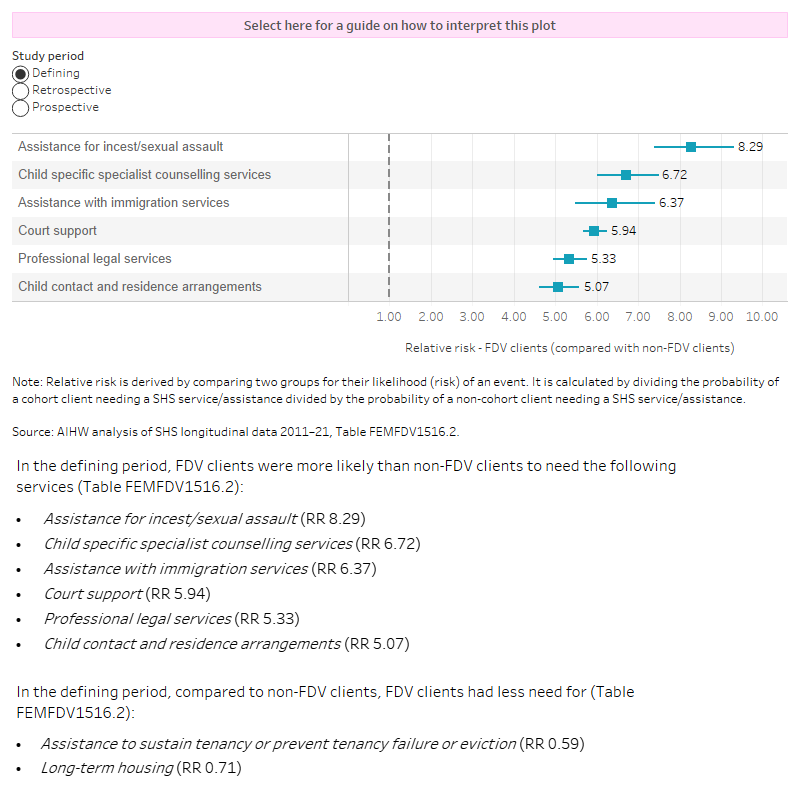Specialist homelessness services client pathways: Female clients with family and domestic violence experience in 2015–16
Citation
AIHW
Australian Institute of Health and Welfare (2022) Specialist homelessness services client pathways: Female clients with family and domestic violence experience in 2015–16, AIHW, Australian Government, accessed 25 April 2024.
APA
Australian Institute of Health and Welfare. (2022). Specialist homelessness services client pathways: Female clients with family and domestic violence experience in 2015–16. Retrieved from https://www.aihw.gov.au/reports/homelessness-services/shs-fdv-2015-16
MLA
Specialist homelessness services client pathways: Female clients with family and domestic violence experience in 2015–16. Australian Institute of Health and Welfare, 07 June 2022, https://www.aihw.gov.au/reports/homelessness-services/shs-fdv-2015-16
Vancouver
Australian Institute of Health and Welfare. Specialist homelessness services client pathways: Female clients with family and domestic violence experience in 2015–16 [Internet]. Canberra: Australian Institute of Health and Welfare, 2022 [cited 2024 Apr. 25]. Available from: https://www.aihw.gov.au/reports/homelessness-services/shs-fdv-2015-16
Harvard
Australian Institute of Health and Welfare (AIHW) 2022, Specialist homelessness services client pathways: Female clients with family and domestic violence experience in 2015–16, viewed 25 April 2024, https://www.aihw.gov.au/reports/homelessness-services/shs-fdv-2015-16
Get citations as an Endnote file: Endnote
PDF | 1009Kb
On this page:
Study cohort – Specialist homelessness services: Female clients with family and domestic violence experience in 2015–16
Introduction
Women who experience family and domestic violence are considered an important sub-group of clients experiencing homelessness (see Women and children experiencing family and domestic violence).
Using the Specialist Homelessness Services (SHS) longitudinal data set, analysis of a cohort of female FDV clients in 2015–16 was undertaken to examine SHS support patterns for a cohort of service users.
See Introduction to the SHS longitudinal data for details on the longitudinal analyses undertaken.
The 2015–16 female FDV SHS client cohort was defined as women, aged 18 and over, who received SHS support at any time during the defining study period in 2015–16, and who:
- nominated FDV as a reason for seeking services, or
- were assessed as needing FDV services or,
- were provided or referred to FDV services.
Although children are included in the NHHA priority group of women and children experiencing family and domestic violence, they were excluded from this specific research insight, partly because of data quality for children, but also because the pathways for child victim-survivors of FDV may be considerably different to that of adult females and may warrant separate analyses.
A comparison cohort (non-FDV cohort) was created, comprising women aged 18 and over that received support at any time during 2015–16 and who did not meet the criteria for inclusion in the FDV cohort. Clients in the comparison cohort did not nominate FDV as a reason for seeking services and were not provided or referred to FDV services in the 12 months from their first support period in 2015–16. They could have, however, experienced FDV and sought FDV services before 2015–16. More information on the how comparison cohorts were derived can be found in the Methodology section.
The longitudinal SHS data for the period 2011–21 were used to (Figure FDV.1):
- examine characteristics of women experiencing family and domestic violence (the FDV cohort) compared with the comparison cohort (the non-FDV cohort)
- examine outcomes for the FDV cohort in terms of historical and future service use.
Figure FDV.1: Female FDV client cohort, longitudinal analysis overview

Source: AIHW analysis of SHS longitudinal data 2011–21, Table FEMFDV1516.1.
Key characteristics of the FDV 2015–16 cohort
There were nearly 55,500 clients of SHS agencies in the FDV 2015–16 cohort with the following key characteristics (Table FEMFDV1516.1):
- The mean age of women was 36 years; with 33% (18,100 clients) aged 24–34 years and 27% (more than 15,100 clients) aged 35 to 44 years at the time of their first FDV-related support period in 2015–16.
- Around 11,700 clients (21%) were Indigenous.
- Almost 10,000 clients (18%) were born overseas.
- Over half (52%, 28,900 clients) had only one support period during the defining study period and 27% (more than 14,900) had 3 or more support periods; support periods after the first might not have involved FDV.
- Less than half (47% or 26,100 clients) had used SHS services previously (in the 48-month retrospective period that preceded the defining study period). Nearly three-quarters (19,000) of these were FDV clients in the retrospective period and 63% (16,400 clients) needed assistance for family/domestic violence (Table FEMFDV1516.3).
- Over 25,000 (45%) clients continued to use services; that is, they received support in the 48 months after the 12-month defining study period.
Not all FDV cohort clients needed FDV services from the SHS agency; around 81% (more than 44,800 clients) needed assistance for FDV services during the 12-month defining study period (Table FEMFDV1516.3). The FDV cohort includes clients who nominated FDV as one of the reasons for seeking SHS support, even if their assessment by the SHS agencies resulted in them not needing FDV services. These clients would have received other (non-FDV) SHS services. Also, they may have received FDV services from non-SHS agencies (See Box FDV.1 for a definition of SHS FDV services), so a need for an FDV specific service was not reported by the SHS agency.
Box FDV.1. What are FDV services?
In the context of Specialist Homelessness Services, FDV services are provided to both victim-survivors and people who use violence (perpetrators) and include:
Assistance for family/domestic violence – victim support services
- One-to-one discussion or group sessions with the client, focused around violence (for example, physical or emotional abuse) inflicted on the client by a family member, including a current or former spouse/partner.
- This includes referring the client for counselling to a family and domestic violence support group, or specialised domestic violence support service for victim-survivors of domestic violence.
Assistance for family/domestic violence – perpetrator support services
- One-to-one discussion or group sessions with the client, focused around perpetrator support services for violence (for example, physical or emotional abuse) inflicted by the client on a family member, including a current or former spouse/partner.
- This includes referring the client for counselling to a family and domestic violence support group, or for specialised perpetrator support services.
Service engagement profiles
Service use patterns of the FDV cohort over the entire longitudinal period (2011–21) were examined. Over a third (20,600 or 37%) of the FDV cohort were short-term clients (they only used services during the 12-month defining study period) (Figure FDV.2, Table FEMFDV1516.1).
Figure FDV.2: Female FDV client cohort 2015–16, service engagement profiles
This interactive bar chart shows service use patterns of the FDV cohort over the entire longitudinal period (2011–21). Support information was combined from the discrete study periods into four service engagement profile groups (historical, short-term, long-term and ongoing). Engagement profiles for all states and territories and Australia can be selected and displayed. Nationally, of the 55,500 clients that made up the study period cohort, over a third (20,600 or 37%) were short-term clients (they only used services during the 12-month defining study period. For NT clients, 42% were long-term clients and had used SHS support at various times over the 10-year period.

FDV cohort compared to the non-FDV cohort
There were 50,800 non-FDV female clients in 2015–16, that is, female SHS clients over the age of 18 who did not nominate as having an FDV issue or needing an FDV service (Figure FDV.3, Table FEMFDV1516.1).
Key differences between the FDV and non-FDV clients, in 2015–16, include:
- The FDV cohort had a different age profile, with a greater proportion aged 25 to 44 years and less aged 18 to 24 years.
- Women in the FDV cohort were less likely to have been homeless (39% or 21,600 clients) at least once during the defining study period compared with the non-FDV cohort (45%, 22,800 clients). However, clients in the FDV cohort (38%, 21,000 clients) were more likely to need short-term/emergency accommodation compared with the non-FDV cohort (32%) during the defining study period.
- FDV clients were much more likely to have owned a home at some time during the defining study period (8%, 4,600 clients) compared with non-FDV clients (1%, 670 clients).
- The proportion of clients with mental health issues or drug or alcohol problems was similar between the FDV and non-FDV cohorts.
Women in the FDV and non-FDV cohorts were generally similar in their historical and ongoing use of services (Table FEMFDV1516.1):
- Less than half (47%) or 26,100 FDV clients and 44% (22,500) of non-FDV clients had used SHS in the 48-month retrospective study period.
- 45% of FDV clients (25,100) and 42% (21,600) of non-FDV clients received SHS support in the 48-month prospective study period.
- The proportion of clients in each service engagement type group (short-term, long-term, historical or ongoing) was similar for the non-FDV cohort, both nationally and within states and territories.
They also had similar patterns regarding employment:
- 38% of FDV clients (20,900) and 39% (20,000) of non-FDV clients were not employed at some point in the retrospective period.
- 37% of FDV clients (20,300) and 38% (19,500) of non-FDV clients were not employed (that is, unemployed or not in the labour force) at some point in the prospective period.
- Clients in the FDV cohort (65%, 35,900 clients) were much less likely to have been unemployed or not in the labour force at some point in the defining study period compared with non-FDV clients (86%, 43,500 clients).
Figure FDV.3: FDV and non-FDV cohort, client key characteristics, by study period, 2015–16
This interactive bar chart shows a comparison between the FDV and non-FDV cohorts, in terms of key characteristics and across all study periods (defining, retrospective and prospective). A radio button allows selection for the individual state/territory and Australia. For Australia, Women in the FDV cohort were less likely to have been homeless (39% or 21,600 clients) at least once during the defining study period compared with the non-FDV cohort (45%, 22,800 clients). However, clients in the FDV cohort (38%, 21,000 clients) were more likely to need short-term/emergency accommodation compared with the non-FDV cohort (32%) during the defining study period. Women in the FDV and non-FDV cohorts were generally similar in their historical and ongoing use of services, less than half (47%) or 26,100 FDV clients and 44% (22,500) of non-FDV clients had used SHS in the 48-month retrospective study period.

How did service needs differ?
Differences in identified service need between FDV and non-FDV clients receiving SHS support were examined using relative risk, which was calculated by dividing the risk of an event occurring for one group (specifically, service need for each service type separately for FDV clients) by the risk of an event occurring for another group (service need for non-FDV clients).
Female FDV clients were 8 times more likely to need assistance for incest/sexual assault (relative risk [RR] 8.29) during the 2015–16 defining study period than women in the non-FDV cohort (Figure FDV.4; Table FEMFDV1516.2). (Note: services for incest/sexual assault are not always FDV-related.)
Figure FDV.4: Relative risk of needing a SHS service type, FDV and non-FDV clients, by study period, 2015–16
The interactive risk ratio plot shows the differences in service need between FDV and non-FDV clients receiving SHS support in each study period, these associations are presented as relative risks. The top 6 services more likely to be needed by FDV cohort clients compared with non-FDV clients (that is, those with the largest relative risk) have been shown in the figure. A radio button allows selection of the services and relative risks for each of the study periods (defining, retrospective and prospective). Female FDV clients were 8 times more likely to need assistance for incest/sexual assault (relative risk [RR] 8.29) during the 2015–16 defining study period than women in the non-FDV cohort. Compared to non-FDV clients, FDV clients had much less need for assistance to sustain or prevent tenancy failure or eviction in the defining study period.

SHS clients – FDV cohort past and future service use
Services provided by SHS agencies was examined for the FDV cohort in each study period (Table FDV.1). Nearly half (around 28,300 clients) of the clients received support from agencies in Victoria. Clients who received support in the Northern Territory were most likely to have also received support in the past (57%), as well as the most likely to receive support into the future (61%).
Table FDV.1. FDV clients 2015–16, by past (retrospective) and future (prospective) service use and state/territory
The table shows the number and per cent of FDV cohort clients within each study period for each state and territory and Australia. Nearly half (around 28,300 clients) of the clients received support from agencies in Victoria. Clients who received support in the Northern Territory were most likely to have also received support in the past (57%), as well as the most likely to receive support into the future (61%).

SHS services needed by FDV cohort clients
Service need and service provision/referral was examined for the female FDV 2015–16 clients that used services in the retrospective, defining and prospective study periods; aggregation is based on services needed or provided/referred in support periods that commenced within each study period only.
Patterns of service use were generally similar across the 3 study periods, except for assistance for FDV and the associated services (for example, legal information), which were greater in the defining period. It is worth noting that some of the female FDV 2015–16 defining cohort clients were not classified as FDV clients in the retrospective (27% of retrospective clients had not experienced FDV) and prospective periods (21% of prospective clients) (Table FEMFDV1516.1).
There were nearly 55,500 female FDV clients in the 2015–16 defining study period, 26,100 were also receiving support in the retrospective study period and 25,100 were receiving support in the prospective study period.
Figure FDV.5: FDV clients 2015–16, select top 10 services and assistance needed and service provision status by study period
The table shows the number and per cent of FDV cohort clients within each study period for each state and territory and Australia. Nearly half (around 28,300 clients) of the clients received support from agencies in Victoria. Clients who received support in the Northern Territory were most likely to have also received support in the past (57%), as well as the most likely to receive support into the future (61%).

Factors associated with past and future SHS service use
Descriptive regression models were used to examine whether client characteristics or support experiences in the defining period were associated with receipt of SHS support in the prospective study period (ongoing service use) or, separately, in the retrospective period (historical service use). Information on interpreting regression models can be found in the section Understanding factors associated with past and future support.
Some bias is present in this outcome measure, however, because some clients that required services in the future may not have been able to receive them (see the section on Bias within the SHSC longitudinal data).
What client characteristics are associated with using SHS services in the retrospective study period?
Certain client characteristics or circumstances are associated with SHS support in the past (relative to the defining study period). However, variations in state- or territory-specific policy and service deliver models mean that the likelihood of a client receiving services in the future varies strongly among states or territories. Therefore, in addition to a national model, separate regression models were created for each state or territory where there was sufficient sample size. The models are descriptive, that is, they are intended to describe the client variables that are associated with past or future service use without proposing or testing specific causal pathways.
The outcome variable (receipt of SHS support) was a binary measure (yes or no) and did not distinguish between clients that needed SHS support only once in the retrospective study period and clients that required frequent support.
Risk ratios were created to measure the association between the use of SHS services and a set of client characteristics (see Glossary entry on Relative Risk for how to interpret the results).
Model results are shown in Figure FDV.6, which shows relative risk for having received SHS support in the past and, separately, in the future for chosen client variables. Results for Tasmania, the Northern Territory and the Australian Capital Territory should be used with caution because there were too few clients in the cohort for these states for a meaningful model (Table FDV.1). Data from these states or territories are included in the national results, though it is important to recognise that Victorian clients represent more than 51% of clients in the national data. Therefore, while the national data are comprehensive and reflect the pathways of all clients in Australia, they are strongly influenced by the Victorian experience and insensitive to the situation in the smaller states or territories.
The results show that, although different in magnitude in each state or territory, having owned a home (40% less likely) or being born overseas (9% less likely), are associated with reduced likelihood of having a history of SHS support. Most other factors, and especially not being employed (39% increased likelihood) or having had mental health or drug or alcohol issues (17% and 15% respectively), are associated with having a history of SHS support. Being an Indigenous Australian also had a strong association (34% increased likelihood) with past SHS support. This is partly due to the social and economic disadvantages faced by Indigenous Australians and a higher prevalence of health risk factors (POA 2014, AIHW 2020).
Figure FDV.6: FDV clients 2015–16, relative risk for use of SHS services in the retrospective and prospective study periods
The interactive risk ratio plot shows the characteristics or circumstances that are associated with the FDV cohort clients use of SHS services in the past (retrospective) or future (prospective period), these associations are presented as relative risks. Relative risks for all states and territories and Australia can be selected and displayed. For both past and future SHS support the associations were similar. The results show that, not being employed at some time in the defining study had a strong association with past and future service use. Although different in magnitude in each state or territory, having owned a home or being born overseas, are associated with a reduced likelihood of having a history or ongoing use of SHS support.

What client characteristics are associated with using SHS services in the prospective study period?
The results largely mirror those for associations with past SHS support (Figure FDV.6; Table FEMFDV1516.4). Although different in magnitude in each state or territory, being an Indigenous Australian had a strong association (45% increased likelihood) with future SHS support in the national data.
Not being employed at some time in the defining study period – specifically, being unemployed or not in the labour force – also had a strong association (40% increased likelihood if clients were not employed in at least one support).
Having an additional vulnerability such as mental health issues or drug and alcohol problems was also consistently associated with an increase in SHS support in the future (17% for both in the national data), while transitioning from custody had a 14% increased likelihood of using services in the future.
Characteristics such as having owned a home at some time during the defining study period, or being born overseas, were associated with a reduced likelihood of using SHS services in the future of roughly 21% and 5%, respectively, in the national data.
Many of these associations concur with those found for a general cohort of SHS clients in 2015–16 and with those found for the non-FDV cohort, meaning that the findings were not specific to FDV clients.
Summary
There were nearly 55,500 women aged 18 and over in the 2015–16 FDV cohort; 21% were Indigenous and 18% were born overseas. Less than half (47%) had used services in the past and 45% continued to use services into the future. Around 29% of FDV clients were long-term clients (needed SHS support over the 10-year period).
Women in the FDV cohort were less likely to have been homeless at some point during the defining study period compared with the comparison group (women without an FDV experience in 2015–16). They were also more likely to need short-term accommodation. These women were also 8 times more likely to need assistance for incest or sexual assault and almost 6 times more likely to require court support than women without FDV experience.
Generally, female FDV clients that were born overseas or had owned a home were less likely to use SHS services in the future. Conversely, vulnerabilities such as mental health or drug/alcohol issues, being Indigenous or – most prominently – having been not employed (unemployed or not in the labour force), tended to increase the likelihood that a client continued to use SHS services in the future.
ABS (Australian Bureau of Statistics) (2017) Personal Safety, Australia, 2016. ABS cat. no. 4906.0, Australian Bureau of Statistics: Canberra.
AIHW (2020) Health risk factors among Indigenous Australians. Australia's health 2020: snapshots. Australia’s health series no. 17 Cat. no. AUS 232. Canberra: AIHW.
AIHW (2021) Specialist homelessness services annual report, AIHW Cat. no. HOU 327. AIHW: Canberra.
CFFR (Council on Federal Financial Relations) (2018) National Housing and Homelessness Agreement. Viewed 18 July 2021.
Diette, C. and Ribar, D. (2015) A longitudinal Analysis of Violence and Housing Insecurity (Melbourne Institute Working Paper Series Working Paper No. 20/15), Melbourne Institute of Applied Economic and Social Research, Melbourne
Flanagan, K., Blunden, H., valentine, k. and Henriette, J (2019) Housing outcomes after domestic and family violence, AHURI Final Report 311, Australian Housing and Urban Research Institute Limited, Melbourne.
POA (Parliament of Australia) (2004) A hand up not a hand out: Renewing the fight against poverty. Report on Poverty and Financial Hardship. Canberra: Senate Community Affairs Reference Committee.
Scutella, R. Johnson, G., Moschion, J., Tseng, Y. & Wooden, M (2012) Journeys Home: Wave 1 Findings (Journeys Home Research Report No. 1, Prepared for the Australian Government Department of Families, Housing, Community Services and Indigenous Affairs), Melbourne, Melbourne Institute of Applied Economic and Social Research.


